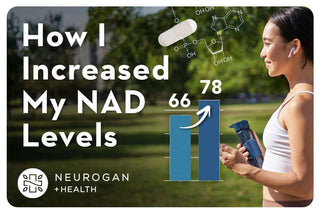You'll never catch me recommending anything I haven't tried myself. So when I started writing about NAD+ supplements and their role in energy production, recovery, and healthy aging, I wanted to put it to the test. Literally.
At 32, I'm fairly active. I resistance train twice a week, indoor rock climb 2-3 times a week, and I'll walk or bike as much as I can instead of driving. I've always felt pretty good, but I was curious about my NAD levels, so I ordered an NAD test kit.
What's An NAD Test Kit Like?
I ordered a dried blood spot (DBS) NAD test kit, which is generally considered accurate, but it's not perfect.
The pro is that it's much cheaper (even though it costs $199) than other methods, such as venous blood draws, and it's something I can do from home, send off in the mail, and get results back via email.

For general baseline NAD tracking, DBS kits should do the trick for most people.
In the kit, you get:
-
Dried blood spot card
-
Finger-prick device
-
Alcohol swab and bandage
-
Paid envelope to send your sample to the lab
The best time to take your NAD test is in the morning when you're relaxed and have a higher pool of NAD. Taking the NAD test after a workout, when you're sick, or when you're stressed could affect the results.
To take the test, you have to clean and then prick your finger and allow the blood to drip onto the outlined circles. Before sending it off, the blood spot card has to be fully dry.
The test takes about 2 weeks to come back, and you'll get mailed a digital report showing the NAD levels and how they compare to the population averages by age and sex.
The average healthy range for NAD levels for my sex and age group is around 20–45 μmol/L, but since we didn't use a full vein-drawn vial as a blood sample, the results are approximations, and they provide an NAD score based on the lab's references.
What Were My NAD Baseline Results?
According to the lab test, my NAD scores were:
|
Marker |
Result |
Reference Range |
Interpretation |
|
NAD+ Score |
66/100 |
Avg for age group: 60–75 |
Within the average for the age group |
|
Percentile Rank |
62nd percentile |
Compared to females 30–35 |
Slightly above average NAD+ levels pre-supplement |
My results are moderate, as expected, based on a questionnaire I filled out. My general activity level helps with supporting natural NAD production, but my various sleep habits and frequent travel may be limiting my NAD levels.
What Were My NAD Results After?
After I've made some lifestyle changes, which include taking an oral NAD+ support supplement, these were my results.
|
Marker |
Result |
Reference Range |
Interpretation |
|
NAD+ Score |
78/100 |
Avg for age group: 60–75 |
Above-average NAD⁺ levels for the demographic |
|
Percentile Rank |
82nd percentile |
Compared to females 30–35 |
Your NAD⁺ level is higher than 82% of your peers |
In three months, I saw an 18% increase in my NAD levels.
What Did I Do To Increase My NAD Levels?
Over the past three months, I made a few changes to support my NAD+ levels — some of which were intentional, and some were just part of life:
-
Changes in exercise training
-
Honing in on my diet to support exercise capacity
-
Invested in a fitness tracker to measure sleep, energy levels, and recovery
-
Started taking NMN daily, preferably something in the 450-900 mg range daily
-
Didn’t travel for 3 months
Changes in My Workouts & Nutrition
The one that wasn't really intentional in my experiment but was part of another health goal was signing up for a half-marathon, so I started training for it (and I'm not a runner). This pushed me to think more seriously about fueling my body properly.
I realized that juggling long-distance running, strength training, and climbing wasn't going to work unless I paid close attention to how I was eating, sleeping, and nutrition — otherwise, I was signing up to burn out.
I switched my workout routine to one strength training day, one hard climbing day, a mobility exercise day, and one running day. This led me to focus on my nutrition, and I signed up for a healthy local meal prep service to help reduce the number of times I went out to eat or ordered takeout, allowing me to keep better track of what I was eating.

Although I typically eat a fairly balanced pescatarian diet, I occasionally struggle with eating on time to avoid blood sugar dips and consistency to avoid snacking. For example, I'd eat breakfast, work throughout the day, and snack, skip lunch, and then eat a late dinner.
However, having easy-to-prepare meals for breakfast, lunch, and dinner has been working well for me. It’s something I always knew was a good idea, but I never really took the time to do the prep work until now.
Fitness Tracker To Monitor Sleep, Stress, and Recovery
To better understand my body's needs on a day-to-day basis and my energy levels throughout my menstrual cycle, I invested in an Oura ring, which has helped me track my sleep, energy, and recovery. It's been a helpful tool in planning my workouts based on how my body feels, ensuring I'm not overtraining.
Started 900 mg of NMN Daily
I also started taking Neurogan Health's NMN capsule supplement—900 mg per day.

I chose NMN over NR or NAD+ itself because NMN is a precursor that’s readily absorbed orally and directly converts into NAD+ once inside the cell. It’s also backed by a growing body of research showing that NMN supplementation can effectively raise NAD+ levels, particularly in active or aging individuals.
I usually take NMN in the morning, along with my other daytime supplements, which include zinc, vitamin B6, and omega-3s and DHA, as well as vitamin D and K. These supplements were recommended based on a blood test I had with my general practitioner.
My Thoughts on Raising My NAD Levels
NAD plays such an important role in so many different processes in the body, so I believe that the best approach to increasing NAD levels is a holistic one.
For me, the biggest drivers have been eating well and recovering properly.
There are studies showing that NAD supplements can increase NAD levels, and my own test results suggest it had an effect.
But outside of a lab, it's hard to know exactly how much of that benefit came from the supplement alone. NAD levels, after all, are influenced by so many factors like genetics, lifestyle, stress, and sleep.
And even without supplements, aerobic exercise has been shown to naturally boost NAD+ and improve mitochondrial function, which is why keeping active is such an important part of the equation of raising NAD pools.
I don’t think I’ll be signing up for long-distance races on a regular basis after this half marathon, but I’m glad I gave it a shot because now running has become a consistent and enjoyable part of my routine.
If your goal of raising NAD is to support healthy aging, like most people, it's not something that's going to be solved with one thing alone — and if you keep in mind that the goal isn't perfection in everything that you do, but rather creating habits that support energy, recovery, and reduced stres, you'll create long-term health habits that hopefully, lead to a very happy and fulfilled healthspan.




